http://www.wunderground.com/weather-forecast/IN/Kakinada.html
↧
10-Day Weather Forecast Kakinada, India
↧
Beer's Law Laboratory
↧
↧
Indian political parties gloss over environment
Indian political parties gloss over environment
WHO confirmed that New Delhi has most polluted air in world, according to data reported by 1,600 cities in 91 countries.
 The country is the world's third-worst emitter of carbon dioxide _ behind China and the United States _ even though a third of Indians still lack electricity.
The country is the world's third-worst emitter of carbon dioxide _ behind China and the United States _ even though a third of Indians still lack electricity.Environmentalists say the omission is alarming given the problems India faces. The World Bank estimates that environmental degradation costs India 5.7 percent of its annual gross domestic product, and causes a quarter of the country’s 1.6 million deaths among children each year.
On Wednesday, the World Health Organization confirmed that India’s capital, New Delhi, has the most polluted air in the world, according to data reported by 1,600 cities in 91 countries.
The three main national groups competing in the elections have published manifestos that touch on the environment, but say little about major problems such as worsening pollution or projections that the country will have only half the water supply it needs by 2030.
Instead, politicians have focused on alleviating poverty, creating jobs and reviving the economy, all key concerns for voters as growth of India’s gross domestic product flagged to 4.7 percent in the past year. The country’s political parties are in the final stretch of a marathon, five-week vote, with results expected May 16.
to help us personalise your reading experience.
“It isn’t possible in a country like India to separate issues of livelihood and environment,” said Ashish Kothari, founder of the Kalpavriksh environmental group. “The fact that it’s not given central attention is extremely scary.”
India’s major rivers have become clogged with garbage, sewage and industrial runoff. The country’s air is now the world’s dirtiest, according to a study by environmental research centers at Yale and Columbia universities.
The country is the world’s third-worst emitter of carbon dioxide _ behind China and the United States _ even though a third of Indians still lack electricity.
Analysts say India’s politicians _ traditionally focused on bagging or buying easy votes while protecting political patronage built on communal identity _ may see the environment as a fringe issue given other, more obvious priorities like lifting 400 million still living in extreme poverty.
They may also be wary of antagonizing industrial or corporate entities, many of whom see environmental protection as an obstacle to profitability.
“There must be money involved for the environment to become an election issue. But preserving, protecting, managing resources, these are not interesting for politicians,” said Raj Panjwani, a lawyer in both India and the United States. “There has to be a calamity continued…
↧
Safety rating for chemical plants: A step in right direction
Safety rating for chemical plants: A step in right direction
The government plans to introduce safety rating system for chemical plants in India will minimises accidents and increase productivity, if implemented in right spirit
Chemical industry involves handling of hazardous substances, which if not handled as per prescribed guidelines can lead to disaster. While there are many regulations (pertaining to safety, environment, handling, manufacturing, etc) for the chemical industry in the country, there is no mechanism by which one can know the level of safety preparedness of the manufacturing unit. In order to usher in safety culture in the chemical industry, the Government is planning to introduce safety rating for chemical plants in India.As a first step, on October 7, 2013, the Department of Chemicals and Petrochemicals, Ministry of Chemicals and Fertilizers, Government of India, announced the proposal to have a rating system for Safety & Security of Chemical Plants in India.
A welcome step
Industry has welcomed the move, which propagates the need for zero accidents. “The industry handles hazardous substances, and, hence, there should be rating system for plants in chemical industry. It will go a long way in promoting the culture of safety in the industry,” said S R Lohokare, Managing Director, National Peroxide Ltd.
Agreed B Karthikeyan, Process Safety Expert, “The safety and security rating system is a good beginning. However, a good process safety record depends on the culture of the organisation and this has to be driven by top management on a day to day basis.”
ALSO READ: Responsible Care: Ensuring safety beyond the factory walls
According to Karthikeyan, the key parameters for safety rating for a chemical plant should balance the needs for both occupational health & safety, and process safety. “Any rating system is a snapshot of the organisations safety performance. However, in process safety management, top management commitment and technical competency of the people who run the system are important for achieving incident free performance,” he added.
Incentivising safety

B Karthikeyan
ALSO READ: Is Indian chemical industry ready for green march?
The proposal for the new safety rating system also suggests that organisations with good safety performance will be incentivised. “This will go a long way in encouraging companies to go for safety ratings, thus helping the industry to improve its safety quotient,” said an industry expert.
Karthikeyan believes that the opposite of this must also be implemented - if an organisation that has been rated either 3, 4 or 5 star in the new rating system experiences a reportable accident after the award of the rating and within the periodicity of assessment, then the rating should automatically be downgraded to ‘Fair’. “This will ensure continued top management focus,” he said.
Rating, will it prevent disaster?
Inadequate awareness about handling of hazardous chemicals and products may lead to serious accidents with severe consequences on people, property and the environment. The rating system facilitates safe & secure handling, storage and processing of hazardous chemicals and in avoiding accidents and occupational diseases.
ALSO READ: Tata Chemicals' Babrala plant wins safety award
But will the safety rating system make chemical plants safer? Karthikeyan answered, “This is a million dollar question. The history of process accidents in the chemical industry indicates that even those organisations with world-class safety management systems do experience fatal accidents or major loss of containment incidents occasionally. But these can be prevented if top management’s eye is on the ball continuously.”
As per the National Disaster Management Guidelines (2007) published by the National Disaster Management Authority, India has about 1666 Major Accident Hazard (MAH) units. Of the 602 districts in India, 263 districts have MAH units. Of them, 170 have clusters of more than five MAH units/hazardous/industrial pockets. “Between 2002 to 2006, 25 major chemical accidents have been reported in MAH units, involving 52 deaths and 238 injuries. The accidents involved chemicals like chlorine, ammonia, LPG and other hazardous chemicals,” informed Karthikeyan.
Experts believe that safety rating can minimise the chances of accidents if implemented in right spirit. “The safety rating system is a good though belated beginning in India. It is better, it is made mandatory for all MAH units in India,” opined Karthikeyan.
↧
Responsible Care: Ensuring safety beyond the factory walls
Responsible Care: Ensuring safety beyond the factory walls
Responsible Care, a voluntary self-regulatory initiative, is gaining traction among Indian chemical manufacturers to ensure safety not just in the factory, but also beyond the factory walls.
| Chemical Risk Management |
| Trusted Environmental Advisor To Businesses And Governments Globallyricardo-aea.com |

“Adoption of Responsible Care means that companies will endeavour to use green chemistry, use less hazardous materials, save natural resources, conserve energy, and drastically reduce hazardous releases to environment. The possibility of any disaster must be eliminated. It is also necessary to provide positive and genuine information to public about the contribution of chemical industry. Open and effective communication is the key to build the trust and confidence of community,” said Yogesh Kothari, President, Indian Chemical Council (ICC), and CMD, Alkyl Amines Chemicals Ltd.

Tata Chemicals' R Mukundan
Need for RC in India
According to Mukundan, Indian chemical companies need to prepare for the emerging prospects to drive growth by tapping the global market, in which India has only 2-3 per cent share. At the same time, the Indian industry must recognise that there will be increasing demand from customer for the highest standards when it comes to ethical practices, sustainability and environmental protection and safety to be global leaders, he added.
Most of the growth in chemical industry has been driven by Asia, which now owns almost half of the global chemical sales. Hence, adopting RC becomes imperative for Indian companies. “I believe that adopting RC initiatives is one of the key areas not only to improve the present functioning of the chemical industry but also to ensure the future growth which is due to the Indian chemical sector,” observed Ravi Kapoor, Managing Director, Heubach Colour Pvt Ltd.

Yogesh Kothari, President, ICC, and CMD, Alkyl Amines Chemicals
The journey so far
RC was introduced in India in 1993 and since then ICC has been taking proactive initiative to propagate this concept in India. “In an effort to spread the RC movement in India, ICC is conducting various awareness workshops, programs designed on new technologies, in collaboration with International Council of Chemical Association (ICCA) through American Chemistry Council and the industry leaders. ICC is seeking technological support from developed countries and the leading international companies to provide support to chemical industry at large in India,” informed Kothari.
Number of companies looking to adhere to RC code from India has been increasing. More than 24 Indian chemical companies have already passed the audit process and are allowed to use the Responsible Care logo to differentiate them from the other manufacturers. And this number is expected to increase in coming days as companies realise the benefits of RC. “We see a far better response from companies wanting to become RC companies. May be surge is too strong a word, but there is definitely a growing awareness of the need for RC initiatives to be adopted on an urgent basis as the chemical industry realises that this is in the best interests of the industry given the history of bad boy image as well as a growing awareness all over the world on Responsible Care practiced by the industries,” said Kapoor.
Benefits in abundance

Heubach Colour's Ravi Kapoor
Agrees Kapoor, and adds, “Overall the Responsible Care initiatives seeks to bring about a complete transparency between all the stake holders in a manner that it removes barriers and hurdles which sometimes put the chemical industry in a unfavourable light. It is also been seen that companies practicing RC actually benefit in terms of reputation, better running of their companies, building trust with society, customers, suppliers, local community and the government.”
Responsible Care is a voluntary initiative, and experts believe to give impetus to its widespread adoption, the government should provide incentives to RC-adhering companies. While the ICC is already in discussion with the concerned ministry at the centre for this, the Gujarat Government has reportedly agreed to grant some concession in terms of longer valid consent period, lower fees and a kind of fast track treatment for RC companies.
While incentive can provide additional encouragement for Responsible Care adoption, the real change will happen only when companies are self-motivated to bring in green initiatives. As Kapoor rightly puts, “At the end, RC is a state of mind and this has to come from the Head of the Company who has to believe this with the heart than the mind and then translate it down the ranks to ensure the success of implementation.”
Some of the benefits of Responsible Care
- Safe and responsible handling of chemicals through the entire life cycle builds public trust and confidence in chemicals and the companies practicing RC
- Reduces pollution & water consumption, improves energy efficiency and usage of renewable energy
- Helps build informed, protected society and sustainable future for everyone
- Improves business management efficiency by better targeting of worthwhile market opportunities
- Reduces the likelihood of unnecessary capital and other expenditure when it becomes clear that risks outweigh further investment in chemical development
- May reduce insurance premiums due to reduction of risks. The developed countries have already realised the benefit. ICC is in discussion with insurance companies. Initial response is positive.
↧
↧
Fertilizer industry wants new govt to ensure stable policy, says Coromandel International MD
HYDERABAD: The Indian fertilizer industry wants the new government coming to power this week to ensure a stable policy framework to minimise the uncertainties and help the industry plan their investments better, says Kapil Mehan, managing director of Coromandel International.
The country's largest phosphatic fertilizer firm views that the frequent changes to urea investment policy over the last six years deterred industry from making fresh investments. Addressing newspersons to annou ..
The country's largest phosphatic fertilizer firm views that the frequent changes to urea investment policy over the last six years deterred industry from making fresh investments. Addressing newspersons to annou ..
Fertilizer industry wants new govt to ensure stable policy, says Coromandel International MD
↧
Transformer explodes in Turkish coal mine; 201 die in fire
Transformer explodes in Turkish coal mine; 201 die in fire
May 14, 2014 -- Updated 0232 GMT (1032 HKT)
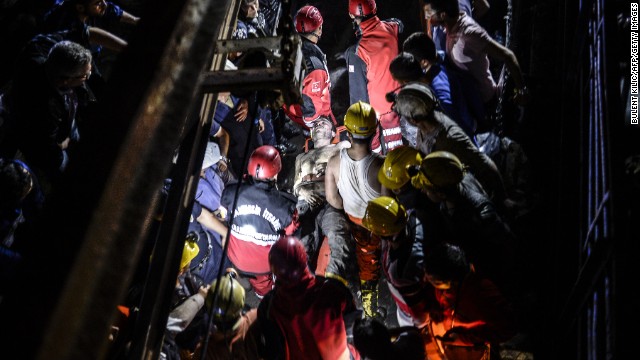
Hundreds stranded as death toll soars
STORY HIGHLIGHTS
- NEW: Official death toll grows rapidly, now at 201 people
- More than 200 workers are still stranded, disaster agency says
- Clean air is reaching parts of the mine where there is no fire, says energy minister
The Natural Disaster and Emergency Coordination Directorate said 80 injured people have been rescued and eight uninjured people were rescued. Crowds gathered around the rescue operation in the post-midnight darkness Wednesday.
Earlier, Manisa Mayor Cengiz Ergun told CNN Turk that the death toll was 157. CNN Turk aired the rescue of one miner to a cheering crowd.
More than 200 workers were still stranded late Tuesday, according to preliminary findings by Turkey's Manisa Natural Disaster and Emergency Coordination Directorate.
Rescue workers and relatives gather at a coal mine in the western Turkish province of Manisa on Tuesday, May 13. A fire caused by a transformer explosion in the coal mine left more than 160 people dead and trapped hundreds more, officials said.![Rescue workers and relatives gather at a coal mine in the western Turkish province of Manisa on Tuesday, May 13. A fire caused by a transformer explosion in the coal mine left more than 160 people dead and trapped hundreds more, officials said.]()
Rescue workers and relatives gather at a coal mine in the western Turkish province of Manisa on Tuesday, May 13. A fire caused by a transformer explosion in the coal mine left more than 160 people dead and trapped hundreds more, officials said.
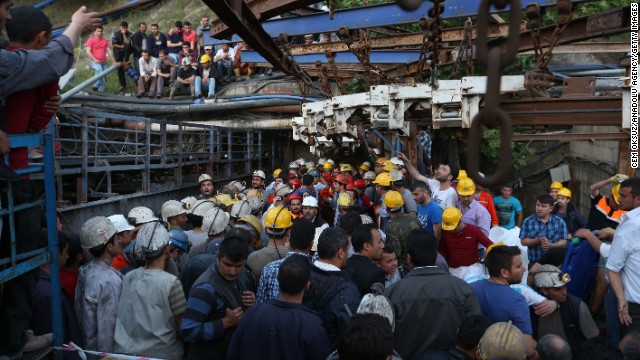
 Photos: Coal mine explosion in Turkey
Photos: Coal mine explosion in Turkey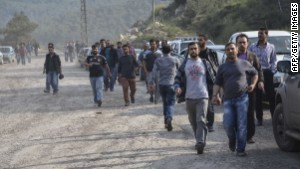 Families hold vigil outside Turkish mine
Families hold vigil outside Turkish mineErgun said 30 workers had been rescued, but he earlier said as many as 400 workers might still be underground.
The mine shaft is about two-thirds of a mile -- or 1 kilometer -- underground, the disaster agency said.
A member of Parliament from Manisa said 16 people were being treated for injuries. The dead and injured seemed to be suffering from burns and suffocation, said Muzaffer Yurttas.
About 100 rescuers, dozens of ambulances and a helicopters were dispatched to the scene, officials said.
"The rescue teams are very experienced," said Yildiz, the minister. "They know what they need to do."
In the initial moments after the blast, "it was important for there to be clean air going underground," Yildiz said. Officials turned an exit pipe "into a clean air pipe," so "there is fresh air being given in places where there is no fire," he added.
Prime Minister Recep Tayyip Erdogan, speaking in Ankara, said the country is working "to rescue our stranded brothers."![An injured miner is carried out by rescue workers. The mine shaft is about two-thirds of a mile -- or 1 kilometer -- underground, a disaster agency said.]()
![Miners stand by after the explosion. About 100 rescuers, dozens of ambulances and helicopters were dispatched to the scene.]()
![Miners and relatives wait outside the mine. Turkish Energy Minister Taner Yildiz said officials turned an exit pipe "into a clean air pipe," so "there is fresh air being given in places where there is no fire."]()
![Rescue operations continue at the site of the accident.]()
![A massive crowd watches as rescuers work into the night.]()
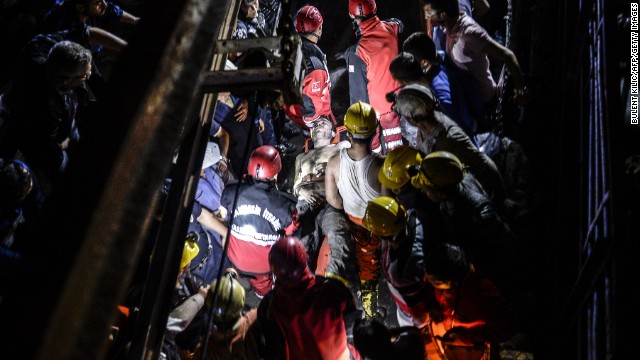
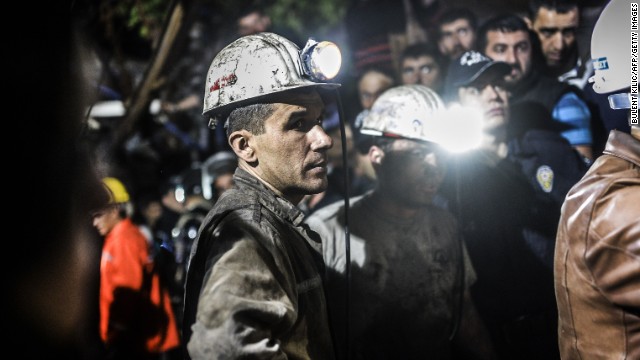
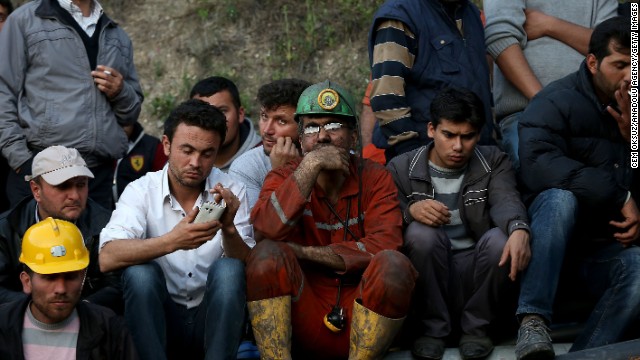
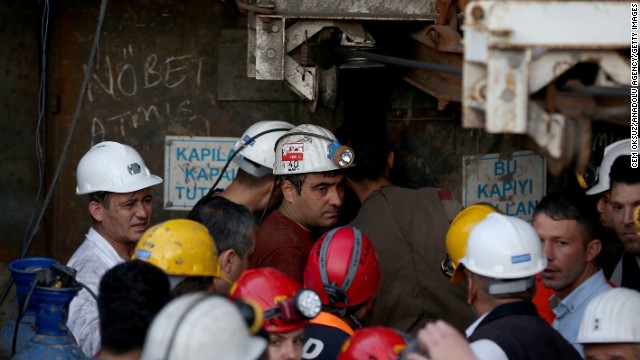
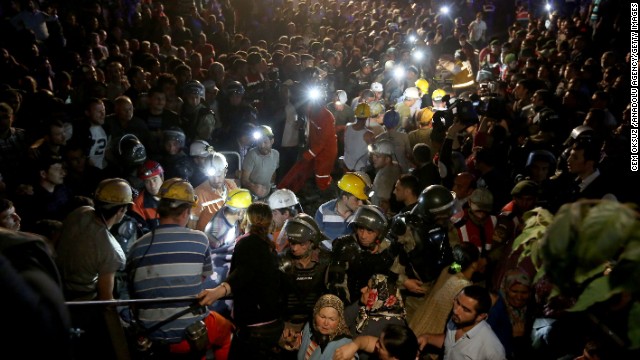
↧
Hourly Weather History & Observations kakinada 14 MAY-2014
Hourly Weather History & Observations kakinada 2014-14 may | |||||||||||
Time (IST) | Temp. | Dew Point | Humidity | Pressure | Visibility | Wind Dir | Wind Speed | Gust Speed | Precip | Events | Conditions |
2:30 AM | 29 °C | 27 °C | 85% | 1006 hPa | 4 km | Calm | Calm | - | - | Partly Cloudy | |
5:30 AM | 29 °C | 27 °C | 87% | 1006 hPa | 4 km | Calm | Calm | - | - | Partly Cloudy | |
8:30 AM | 32 °C | 28 °C | 74% | 1007 hPa | 10 km | Calm | Calm | - | - | Scattered Clouds | |
11:30 AM | 36 °C | 26 °C | 46% | 1006 hPa | 10 km | SSW | 3.7 km/h / | - | - | Scattered Clouds | |
2:30 PM | 40 °C | 24 °C | 31% | 1003 hPa | 10 km | SW | 5.6 km/h / | - | - | Scattered Clouds | |
5:30 PM | 37 °C | 27 °C | 49% | 1002 hPa | 10 km | SW | 3.7 km/h / | - | - | Scattered Clouds | |
8:30 PM | 31 °C | 29 °C | 86% | 1005 hPa | 4 km | SW | 3.7 km/h / | - | - | Clear | |
11:30 PM | 30 °C | 29 °C | 90% | 1005 hPa | 4 km | Calm | Calm | - | - | Scattered Clouds | |
↧
Article 370
Article 370
- Article 370 of the Constitution is making a mockery of secularism, nationalism and the structure of unity. This temporary constitutional provision has, in fact, been providing encouragement for the establishment of Muslim nation.
With the blindfold of political interest we lent permanancy to the temporary character of the Article making our position not only ridiculous before the world but also provided a golden opportunity and solid base for separatist-oriented terrorism to grow in Kashmir. The most shameful part is that we are not ready evennow to throw off the soiled blindfold. Instead we are keen to keep this blindfold as a permanent feature.
Our Government has deliberately concealed the dangers of Article 370 because it will expose the hollowness of its secularism. The exposure of its dangerous consequences will cut asunder the web of pro-Muslim policies.
It is because of this Article that the Government of India cannot enforce any law connected with Jammu and Kashmir without the approval or concurrence of the State Government. Only defence, external affairs and communications fall in the central list. Against this the Parliament has the powers to frame laws for rest of the states in the country. But Article 370 of the Constitution restricts the hands of the Union Government and the Parliament in doing this in case of Jammu and Kashmir. Its dangerous consequences have been witnessed in recent years when the law prohibiting misuse of religious places could not be extended to Jammu and Kashmir with the result the state does not come within the ambit of secularism. And even after the independence the ignoble thing happened in Kashmir where hundreds of temples were destroyed and where people belonging to a particular community were victimised and subjected to cruelties. On the question of Ayodhya nnd the consequent Babri Masjid episode the Union Home Ministry had been issuing threats to the Uttar Pradesh Government and ultimately the Government was dismissed under Article 356 of the canstitution but this article cannot be implemented directly in Jammu and Kashmir.
The President of India cannot dare to issue any order under Article 356 to Jammu and Kashmir. The President has no right to suspend his Constitution in the State. The National emergency under Article 352 of the Constitution can be extended to Jammu and Kashmir to a limited extent and the financial emergency under Article 360 cannot be enforced in Jammu and Kashmir.
Under part four of the Constituion of India there is procedure for one constitutional practice, one administrative structure and one economic pattern. But under Article 370 Jammu and Kashmir has its right under its own constition to do whatever it likes. It is because of the separate flag and separate symbol that two flags flutter on the Government buildings in the state. For hoisting freely the National flag, permission has to be sought from the State flag because it is necessary to hoist the national flag with the state flag.
There is only one system of citizenship for the people of the country but in case of Jammu and Kashmir, it is dual citizenship, one of the state and the other of India. The citizens of Jammu and Kashmir are citizens of India but the citizens of the rest of India cannot be citizens of Jammu and Kashmir. He does not have the right to have property and the right to vote in Jammu and Kashmir. If a girl belonging to Jammu and Kashmir marries a boy from outside the state, who is not a state subject, she loses all her rights in the state. Even the wealth tax cannot be imposed in the state. The Urban Land Act, 1976, which is in force in the entire country is not applicable to Jammu and Kashmir. The result of it is that rich landlords, belonging to the majority community in the Valley, indulge in economic exploitation of the poor and the Indian citizens, who are non-state subjects and living in the valley, cannot even secure loans from the financial institutions.
It is because of Article 370 that political groupism receives encouragement and no local nationalist Government can remain durable if it is not the product of anti-national elements. The state Government did not accept the Anti-defection law adopted in the country and instead made several amendments. Here the decision on defection is not taken by the speaker of the Assembly but by the leader of the connected political party. This gives constitutional legitimacy to the unbridled authority of the leader of the party. Since the Governor usually is not a citizen of the state, he has no right to vote, the separatist elements treat him an outsider and equate themselves with slaves. During the 80's the Wazir Commission had recommended measures forpolitical reforms in Kashmir but due to Article 370 these recommendations have not been implemented.
Burning of the national flag is not a cognizable offence in Kashmir because there cannot be proper arrangement for the basic duties enshrined in the Constitution under which the tricolour, the national anthem and the national symbol have to be shown due respect. Under Article 370 the Indian Parliament cannot increase or reduce the borders of the state. The Union Government implements international agreements and accords under Article 253 of the Constitution but Jammu and Kashmir is beyond its jurisdiction. Muslims from other parts of the country become successful in getting the citizenship of the Jammu and Kashmir but about one lakh Hindus, who had been uprooted in the neighbourhood at the time of the partition, have not been given citizenship so far. Under the umbrella of Article 370 the fundamentalists have received strength in their campaign for Islamisation.
Article 370 revives the two-nation theory and secures security for it in the future. On one side we proclaim in the world that in India their is no discrimination on the basis of religion, community or sect, on the other hand special facilities are being given to Kashmir because there the Muslims are in majority. If these special privileges are being given on the plea that Kashmir is a backward area, is there no other place in india where backwardness and poverty are less important ? In fact several thousand crores of rupees have been spent in Kashmir and the result is apparent. Anti-national elements are active. Instead of bringing the people to the national mainstream, we have, in comparison to other states, given unlimited rights to the people which have made them a pampered lot. People of Kashmir became suspicious about the accession and the anti- national elements got an opportunity for launching an open disinformation campaign against India. Pakistan supported these separatist organisations. The result was that Kashmiri youths picked up arms against India and forced over three lakh Hindu patriots to leave their houses and property in Kashmir and live in the plains a life of penury and misery.
Our Constitution gives equal rights to all citizens but this right is not available in Jammu and Kashmir. It is the tale of local versus non-local who are not state subjects. They do not enjoy any political and economic rights. Their wards cannot get admission in the colleges in Kashmir. Article 370 has violated the principle cf Indian citizenship. The maker of the Constitution of India, Dr. Ambedkar, had cautioned Nehru on the plea that it can create difficulties in full integration of the state with India. This Article would sow the seeds of separatism in the Valley. At least Dr. Ambedkar's warning can be understood now but the politics of vote appeasement does not allow it.
It is quite evident that Article 370 has not integrated Jammu and Kashmir with India but it has delinked it. There in Kashmir is no place for secularism and nationalism in the mind of the youth. The feelings of regionalism, communalism and separatism have been developed in their mind. Instead of coming closer to the national mainstream, they have distanced themselves from it and have now started raking up the question of independence. On April 7, 1958 the Plebiscite Front, of Sheikh Abdullah adopted a resolution and the wording of the resolution clearly indicates how Kashmiri leaders have been working for making the Muslim society anti-India and pro-Pakistan and for this the leaders took the refuge under Article 370. The resolution had made a mention of this Article and said:
"Jammu and Kashmir state has not yet acceded to any of the two dominions, India and Pakistan. Therefore, it will not be right to call Pakistani invasion on Jammu and Kashmir as an attack on India."
Under Article 370 Kashmiri Muslim leaders have been opposing any welfare schemes formulated by the Government of India. No scheme relating to family welfare, formulated by the Government of India, is in force in Kashmir. The programme was implemented in the Jammu region becawe of being a Hindu majority area. A former Chief Minister, G.M. Shah, had said that the aim of the Government family planning programme was to convert the Muslim majority into a minority. Such type of false propaganda has given birth to separatism which received shelter under Article 370.
According to a former Governor, Jagmohan, Article 370 should be scrapped because it has become an instrument of injustice and inequalities. It waters the roots of corrupt elements. It nourishes narrow-minded and reactionary forces. It fully accepts the principle of two-nation theory. It fills the mind of the youth with the garbage of false desires. It gitres birth to narrow lines and narrow faith. This encourages and nourishes regional tensions.
Historical facts reveal that prior to this Article, both Hindus and Muslims were part of the national mainstream. There was no animosity or hatred. During the 1947 Pakistani aggression on Kashmir, Kashmiri Muslims not only welcomed the Indian Army but also assisted them in nabbing the infiltrators. Then why the same Muslim society is launching an attack on the Indian Army at present? This is the result of the poison of Article 370. On seeing the Poisonous impact of this Article on the Kashmiri mind that a former External Affairs Minister, M.C. Chagla, had told the United Nations that the Article was a temporary measure. This Article should be abolished. The two former Chief Ministers of Jammu and Kashmir, Bakshi Ghulam Mohammad and G.M. Sadiq, too wanted this Article to be repealed. The Government of India too had assured people that when the time comes, the Article would be scrapped. But our political interests and the mean and directionless politics of vote bank based on appeasement have not allowed this to materialise. By duping people in the name of secularism, removal of poverty and promotion of equality our leaders have abolished the Privy purses but it is difficult for them to abolish Article 370 for the sake of the integrity of the country. Who will make these leaders understand that after having tasted the bitter fruit of Article 370 let them watch the other side of the coin by abrogating the Article. The armed struggle for liberation is not something separate from the demand for plebiscite and self-determination.
This Article, meant to be a temporary clause in the Constitution, has become a special barrier which is promoting and encouraging Muslim state in the Kashmir valley. This anti- national Article has strengthened its roots because of our weak policies, wavering decisions and growing Islamic fundamentalism and this Article cannot be abrogated so long Governments, favouring the policy of appeasement, remain in power in the centre. This Article opens the door for subversion in the country. The basic idea behind the Anandpur Sahib resolution of the Akalis is the same Article 370. This Article is not a constitutional necessity. The special status given to Jammu and Kashmir is an insult to the people of all other states in the country. There are innumerable facilities, under this special status, for the people who have begun their revolt against India and who are conspiring for Islamisation of entire India, against helplessness and suffocation for people who are nationalists and are one with the ups and downs of India. Article 370 is like a piece of bone stuck in the gullet: if it is swallowed, it may lead to death and if not, still death is there. But when the bone has become dangerous for the existence of the body. it is better to throw it out. There is now need for the abrogation of Article 370 in the interests of security and integrity of the country. It is the need of hour to fully integrate the state with India by abolishing the special status and by abrogating its own consitution.
A political section is of the opinion that this Article cannot be abrogated. But according to Dr. Babu Ram Chauhan, an expert on international law and the Constitution of India, this Article can be scrapped even without the concurrence and approval of the state Assembly The President of India and the Indian Parliament can repeal it. It is clear from Articles 3 and 5 of the State Constitution that Jammu and Kashmir state will remain an "inseparable" part of India. The Constitution of Jammu and Kashmir has been framed under the Constitution of India. Why cannot the Government abrogate the Article in the interest of the nation when the same Government has allowed the State to frame its constitution ?
The utility of Article 370 has been finished now. Its utility has ceased with the people in Kashmir having launched an open revolt and with their guerrilla war against the Indian Army. It is nothing but ridiculous to tell a man, who has come to kill you, to slap you and forge an agreement. What is the meaning af the bait af Article 370 for those who are fully equipped with arms to secure independence for Kashmir? Will a glutton feel satisfied with a crumb ? Now only one way is left: launch a full military campaign against the anti-national elements for finishing them and start, on a war footing, measures for bringing the remaining Kashmiri society to the national mainstream. For this there is need for a search of nationalist leadership among the Kashmiri youth, particularly the Muslim youths. This plan can fructify only after giving up the politics of narrow-mindedness. This is certain that it can pave the way for the national plan of abrogating Article 370.
↧
↧
Indian Embassy
Indian Embassy
INTRODUCTION ON EMBASSY
 | One country’s chief diplomatic office in another (generally in the capital city of the host country) where the main diplomatic officer is the ambassador (or high commissioner, in British Commonwealth) is called an Embassy. Embassy premises and its entire diplomatic staff fall below the sovereignty of the ambassador’s abode country and are confined under the notion of diplomatic immunity by the host country. |
The Indian Embassy building with a statue of Mahatma Gandhi in the foreground.
The Role of Indian Embassy
An embassy is well thought-out to be a diplomatic mission that is stable in a country. The person who takes up the everyday jobs of running the mission is the ambassador of the country. The task of the Indian Embassy is to proceed as a legal link amid India and the rest of the world bringing out vital developments that widen the economic conditions of the country. |
The role of the ambassador and his embassy is to guard the rights and interests of the receiving and the sending States and its nationals. This should be done with the acquiescence of the international law through legal discussions with both the receiving and the sending States. The Ambassador should do his duties with all authenticity and stand by the rules and regulations of the law in the country. Friendly associations between the two States are preserved throughout the promotional period of raising the scientific, economic and cultural relations between States. The smooth and legal functioning of the Indian Embassy is based on these principles wherein the Indian Government sends and receives details on the improvement of the country and the welfare of its citizens. |
Embassies like the Indian Embassy and countries that have their own embassies contribute to a diplomatic relationship with Commonwealth countries that do not have their own embassy. On the other hand these countries have high commissions headed by the high commissioner of that country. The Indian Embassy affords political services to the commonwealth countries’ citizens through the high commission, helping them to benefit from cooperation between two consular services of each country. |
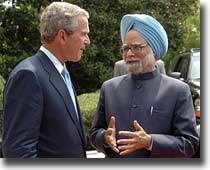 | The role of the Indian Embassy is meaningful and legal making a spot on all countries in the world with its diplomatic and legal laws that are followed in every country by its well-organized and dynamic ambassadors of India. It is a cause of goodwill to the Commonwealth countries and a common podium for sharing of opinions and carrying out goodwill projects to profit the citizens of all the countries in the world. |
Canada and India have a bilateral relationship based on shared values of democracy, pluralism and a mutual interest in expanding trade. In India, Canada is represented in many different cities with a high commission of Canada in New Delhi, two consulate generals in Chandigarh and Mumbai, a consulate in Chennai and trade offices in Ahmedabad, Bangalore, Hyderabad, and Kolkata. In Canada, India is represented with a High Commission in Ottawa and by consulates in Toronto and Vancouver. Their relationship allows tourists and business men to travel easily between India and Canada thanks to the cheap flights Expedia has to offer.
|
↧
The United Nations Secretary-General Message on World Environment Day, 5 June 2014
The United Nations Secretary-General Message on World Environment Day, 5 June 2014
 World Environment Day 2014 falls during the International Year of Small Island Developing States, declared by the United Nations General Assembly to raise awareness of the special needs of this diverse coalition as part of the global discussion on how to achieve a sustainable future for all.
World Environment Day 2014 falls during the International Year of Small Island Developing States, declared by the United Nations General Assembly to raise awareness of the special needs of this diverse coalition as part of the global discussion on how to achieve a sustainable future for all.The world’s small island nations, which are collectively home to more than 63 million people, are renowned as prized destinations: places of outstanding natural beauty, vibrant culture and music appreciated around the globe. While small in total, the land size of small island nations does not reflect their importance as stewards of nature’s wealth on land and sea. They play an important role in protecting the oceans and many are biodiversity hotspots, containing some of the richest reservoirs of plants and animals on the planet.
Despite these assets, Small Island Developing States face numerous challenges. For a significant number, their remoteness affects their ability to be part of the global supply chain, increases import costs – especially for energy – and limits their competitiveness in the tourist industry. Many are increasingly vulnerable to the impacts of climate change – from devastating storms to the threat of sea level rise.
Small Island Developing States have contributed little to climate change. Their combined annual output of greenhouse gases is less than one per cent of total global emissions, but their position on the front lines has projected many to the fore in negotiations for a universal new legal climate agreement in 2015. Others are leaders in disaster preparedness and prevention or are working to achieve climate neutrality through the use of renewable energy and other approaches.
Small island nations share a common understanding that we need to set our planet on a sustainable path. This demands the engagement of all sectors of society in all countries. On World Environment Day, millions of individuals, community groups and businesses from around the world take part in local projects –from clean up campaigns to art exhibits to tree-planting drives. This year, I urge everyone to think about the plight of Small Island Developing States and to take inspiration from their efforts to address climate change, strengthen resilience and work for a sustainable future. Raise your voice, not the sea level. Planet Earth is our shared island. Let us join forces to protect it.
↧
Message of the UN Under-Secretary General and UNEP Executive Director, Achim Steiner
Message of the UN Under-Secretary General and UNEP Executive Director, Achim Steiner
 Every year, on June 5th, millions of people across the planet celebrate World Environment Day—coming together at community, national and regional level to promote positive action on the most-pressing environmental challenges of our day. This year’s global host for World Environment Day is Barbados, one of many Small Island Developing States (SIDS) facing multi-dimensional issues that require integrated global action.
Every year, on June 5th, millions of people across the planet celebrate World Environment Day—coming together at community, national and regional level to promote positive action on the most-pressing environmental challenges of our day. This year’s global host for World Environment Day is Barbados, one of many Small Island Developing States (SIDS) facing multi-dimensional issues that require integrated global action.SIDS contribute little to the problem of climate change—the combined annual carbon dioxide output of these nations accounts for less than one per cent of global emissions. Yet they are especially vulnerable to the changing climate due to their small size, narrow resource base, susceptibility to natural hazards, low economic resilience, and limited for mitigating and adapting to the effects of climate change. The very existence of low-lying nations, such as Kiribati, Maldives, Marshall Islands and Tuvalu is threatened by climate change-induced sea level rise.
As one of the smallest independent states in the world, with a total land area of just 431 km2, Barbados faces many of the challenges outlined above, but it is not passively accepting its fate. Barbados has long been a leader in the Caribbean region in the Green Economy approach. Its current National Strategic Plan (2006-2025) clearly identifies “Building a Green Economy: Strengthening the Physical Infrastructure and Preserving the Environment” as one its key aims.
Barbados’s transition to a green economy offers opportunities for managing natural capital, further diversifying the economy, increasing resource efficiency and supporting the goals of poverty reduction and sustainable development. Tremendous potential exists for greening the agriculture, fisheries, building, transportation and tourism sectors, and Barbados is demonstrating the political will to move to a Green Economy both through its policies and engagement with the United Nations Environment Programme by hosting World Environment Day.
Overall, climate change adaptation is a top priority in SIDS, but lack of financial resources is an obstacle. However, considering that the capital cost of sea-level rise in the Caribbean Community Countries alone is estimated to reach US$187 billion by 2080 under current practices, investing now to head off such a massive economic impact makes sound business sense.
The right enabling conditions are vital to generate and stimulate both public and private sector investments that incorporate broader environmental and social criteria, and thus address this growing challenge. You can contribute to this movement by joining us, in Barbados or wherever you are in the world, in celebrating World Environment Day and raising your voice to encourage action.
↧
Message from Christiana Figueres, Executive Secretary of the UN Framework Convention on Climate Change in Support of World Environment Day 2014 - "Raise Your Voice Not the Sea Level"
Message from Christiana Figueres, Executive Secretary of the UN Framework Convention on Climate Change in Support of World Environment Day 2014 - "Raise Your Voice Not the Sea Level"
 The UN International Year of Small Island Developing States (SIDS) comes at an important moment in the evolution of the international climate change process. 2014 is the year when nations need to lift their eyes beyond business as usual to one of greater ambition in order to deliver on a new and meaningful climate agreeme nt in Paris in 2015. Small island s along with the Arctic and many coastal zones are on the frontline of extreme climate and sea level rise that risks lives, livelihoods and even entire countries .
The UN International Year of Small Island Developing States (SIDS) comes at an important moment in the evolution of the international climate change process. 2014 is the year when nations need to lift their eyes beyond business as usual to one of greater ambition in order to deliver on a new and meaningful climate agreeme nt in Paris in 2015. Small island s along with the Arctic and many coastal zones are on the frontline of extreme climate and sea level rise that risks lives, livelihoods and even entire countries . Small islands are also leaders under the UN Framework Convention on Climate Change (UNFCCC) both morally and practically in terms of reminding nations of the risks and collective responsibilities to act while driving ambitious national and international action -- not least in championing the establishment last year o f the Warsaw international mechanism for loss and damage .
SIDS are also actively leverag ing the many opportunities and mechanisms that the UN climate change regime has generated to support countries towards a more sustainable future . From an economy - wide integration of climate change adaptation and disaster risk management in Samoa to improved adaptation of water resources in the Comoros , many of these nations have undertaken National Adaptation Programmes of Action under the Convention.
Similarly, from wind power projects in Cape Verde, the Dominican Republic and Jamaica to methane capture in Papua New Guinea and Cuba, the islands have been leveraging the UN Clean Development Mechanism to build their own clean energy futures.
However, the global effort to deal with climate change is still not enough — greenhouse gas concentrations in the atmosphere are at their highest for 800,000 years . Yet, the combined effort of governments and business, cities and citizens to act against climate change has never been higher .
It is time to push this groundswell forward towards a new a greement that must include a global commitment to reduce greenhouse emissions rapidly enough to keep a global temperature rise under 2 degrees Celsius this century . This is the promise the world must deliver to the Small Island Developing States .
↧
↧
60 percent population living below poverty line IN Pakistan: World Bank report
60 percent population living below poverty line: World Bank report
 Sixty percent of Pakistan''s population is living below poverty line, a World Bank report entitled World Development Indicators (WDI) 2013 said on Saturday. The international poverty line is two dollars a day or an income of Rs 200 per day. The report shows that 21 percent of Pakistan''s population lives below $1.25 per day.
Sixty percent of Pakistan''s population is living below poverty line, a World Bank report entitled World Development Indicators (WDI) 2013 said on Saturday. The international poverty line is two dollars a day or an income of Rs 200 per day. The report shows that 21 percent of Pakistan''s population lives below $1.25 per day. A comparison of regional countries showed that the poverty rate in Sri Lanka and Nepal was significantly less than Pakistan with 23.9 percent and 57.35 percent, respectively. The poverty rate in India and Bangladesh was higher than Pakistan with 68.7 percent and 76.5 percent. Analysis of the data revealed that 30.9 percent of children under the age of five are suffering from malnutrition and underweight. Mortality rate under five is 72 per 1000 birth-rate and maternal mortality ratio is 260 per 100,000 births. The youth literacy rate was recorded at 71 per cent for age 15-24 and primary completion rate was 67 per cent of relevant age group. The vulnerable employment, the proportion of unpaid family workers and own account workers in total employment was 63 percent in Pakistan.
Environment indicators show that average annual deforestation in the country is 2.24 percent cent and 9.8 percent of the terrestrial and marine area of the total terrestrial and marine area is nationally protected. The internal renewable freshwater resources are 311 per capita cubic meters and 92 percent of the total population has access to improved water resources. About 48 percent population, according to WDI, has access to improved sanitation facilities. The average annual growth in urban population is 2.7 percent.
According to WDI economic indicators, economic growth of Pakistan for the current fiscal year is forecast at 3.9 percent. The country''s military expenditures are reported at 3 percent of the GDP during 2011 and stock market capitalisation 15.6 per cent and domestic credit provided by the banking sector 43.3 percent of the GDP for the period. The tax revenue collection by the central government was recorded at 9.3 percent of GDP in 2011 and electric power consumption per capita 457 kilowatt per hour in 2010. The mobile cellular subscription was 62 people per 100 individuals and 1.8 percent high technology exports of the total manufactured exports in 2011.
↧
Wind, solar energy to get big push under Narendra Modi-led NDA
Wind, solar energy to get big push under Narendra Modi-led NDA

Modi will be country's first energy literate Prime Minister and expanding clean power generation will be his administration's top energy-related priority, especially solar and wind energy, because it has the potential to create jobs and supply power to millions of scattered households not connected to the grid.
About 400 million people in India lack access to electricity, more than the combined population of the US and Canada.
Industry officials said the NDA government may come out with a separate offshore wind energy policy and allow companies to initially set up offshore wind farms up to 12 Nautical Miles from Coast as part of its overall plan to achieve energy security and bring down carbon emission.
The new government is also expected to reinstate accelerated depreciation for investments into wind energy projects and accord priority sector lending for the entire renewable energy segment to give a fillip to non-conventional energy resources.
Tulsi Tanti, Chairman Suzlon Group, said, "We believe the BJP-led government will provide an environment conducive for growth and investments, with major reforms in the infrastructure and renewable energy sector. This is important as India's economic environment will act as a catalyst in reviving the global economy."
Suzlon has already announced plans to enter offshore wind power generation in India in a big way. It has already successfully set up a number of offshore wind generation units globally with Germany's Alpha Ventus Project 60 kms from shore.
"Renewable energy is the only long-term sustainable solution and an answer to issues around global warming. Within this, the solar power specifically can address rural electrificationBSE 5.00 % challenge.
"Two key factors are cost effectiveness and maximising deployment -- policy changes supporting land acquisition, ease of finance and long-term PPAs would boost the renewable energy sector," said Sameer Gupta, Managing Director, Jakson Group.
The BJP's election manifesto promises a 'comprehensive energy policy' to harness oil, gas, hydro, ocean, wind, solar, coal and nuclear energy.
In Gujarat, where Narendra Modi was chief minister for 12 years, political appointees were ejected from state ventures and power utilities and made the companies autonomous and professionally run, helping them turn profitable.
↧
Environment: Clear the air on green clearances
Environment: Clear the air on green clearances
http://timesofindia.indiatimes.com/Home/Environment/Pollution/Environment-Clear-the-air-on-green-clearances/articleshow/35494554.cms
The new government needs to bring in second-generation reforms for environment which can strike a balance between the need for economic development and rights of a local community. This is a tough job, but necessary. At present, green issues are being handled both at the central and state levels. This needs to be streamlined. The top priorities for the environment ministry are: Set up a `national environmental regulator' that carries out appraisal of projects and provide clearances in a transparent and time-bound manner. Government is bound by a Supreme Court order to set up such a national regulator.
The target of increasing forest cover from 21% to 33% of the geographical area must be met under the 'Green India Mission'.
The level of air pollution in cities is alarming. Measures like reducing consumption of fossil fuels, monitoring vehicular pollution and improving public transport are essential.
Build sewage treatment plants across the country to deal with river and groundwater pollution.
'Waste to Energy' concept must be popularized through incentives to private players.
Bring strict effluent control laws in line with the 'polluter pays' principle and ensure rigor ous enforcement.
Focus on renewable (solar and wind) energy through incentives and investment under a national energy policy which may reduce the dependence on fossil fuels.
This will cut India's import bills as well as reduce air pollution.
The target of increasing forest cover from 21% to 33% of the geographical area must be met under the 'Green India Mission'.
The level of air pollution in cities is alarming. Measures like reducing consumption of fossil fuels, monitoring vehicular pollution and improving public transport are essential.
Build sewage treatment plants across the country to deal with river and groundwater pollution.
'Waste to Energy' concept must be popularized through incentives to private players.
Bring strict effluent control laws in line with the 'polluter pays' principle and ensure rigor ous enforcement.
Focus on renewable (solar and wind) energy through incentives and investment under a national energy policy which may reduce the dependence on fossil fuels.
This will cut India's import bills as well as reduce air pollution.
↧
What is humidex? What is the importance of humidity?
What is humidex?
Humidex is a measure of how hot we feel. It is an equivalent scale intended for the general public to express the combined effects of warm temperatures and humidity. It provides a number that describes how hot people feel, much in the same way the equivalent chill temperature, or "wind chill factor," describes how cold people feel. Humidex is used as a measure of perceived heat that results from the combined effect of excessive humidity and high temperature.Environment Canada uses humidex ratings to inform the general public when conditions of heat and humidity are possibly uncomfortable.
| Table 1 | |
|---|---|
| Humidex Range | Degree of Comfort |
| 20-29 | comfortable |
| 30-39 | some discomfort |
| 40-45 | great discomfort; avoid exertion |
| above 45 | dangerous; heat stroke possible |
What is the importance of humidity?
The body attempts to maintain a constant internal temperature of 37°C at all times. In hot weather, the body produces sweat, which cools the body as it evaporates. As the humidity or the moisture content in the air increases, sweat does not evaporate as readily. Sweat evaporation stops entirely when the relative humidity reaches about 90 percent. Under these circumstances, the body temperature rises and may cause illness.What are some of the hazards of working in hot environments?
There are several common heat-related illnesses. Some are more severe than others.Heat rash, or prickly heat, occurs when blocked sweat glands become inflamed. This painful rash reduces the body's ability to sweat and to tolerate heat.
Heat cramps are painful spasms of the muscles. The muscles used in doing the work are most susceptible. The spasms are caused by the failure of the body to replace its lost body salts and usually occur after heavy sweating.
Heat exhaustion results when the body loses large amounts of fluid by sweating during work in hot environments. The skin becomes cool and clammy. Symptoms include profuse sweating, weakness, dizziness, nausea, and headaches.
Heat stroke is the most serious condition and requires immediate medical attention. The body temperature becomes very high (even exceeding 41°C). Complete or partial loss of consciousness is possible. Sweating is not a good symptom of heat stress as there are two types of heat stroke -- "classical" where there is little or no sweating (usually occurs in children, persons who are chronically ill, and the elderly), and "exertional" where body temperature rises because of strenuous exercise or work and sweating is usually present.
Can workplaces use humidex to monitor conditions that may result in heat-related illness?
Humidex as reported by weather forecasters is intended for the general public to express the combined effects of warm temperatures and humidity.Heat-related illnesses depend on many workplace factors in addition to air temperature and humidity. Wind speed or air movement, work load, radiant heat sources and a person's physical condition are also important.
Under certain workplace conditions, the humidex may serve as an indicator of discomfort resulting from occupational exposures to heat.
For example, when humidity is high, but when work load, wind speed and radiant heat sources do not significantly contribute to the heat burden, humidex may be useful. Offices are typical of workplaces where humidex could be used. It is important to use the values of the temperature and relative humidity obtained by actual measurements taken in the workplace. Conditions inside the workplace may significantly differ from those given by the Weather Service.
How do I know what the humidex is?
If you know the temperature and relative humidity, the following chart can be used to determine the humidex rating. For example, if the temperature is 30°C and the relative humidity is 70%, the humidex rating is 41. This level is considered a level of "great discomfort" and exertion should be avoided.Table 2
![Table 2 - Humidex from temperature and relative humidity readings]()
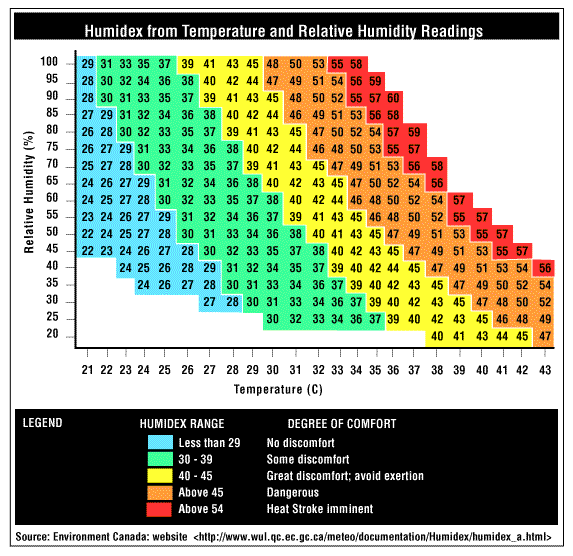
↧
↧
Framework for Safety Culture -CONTINUAL IMPROVEMNENT
Framework for Safety Culture
The organization's culture provides the framework for introducing safety education and safe practices. Organizational culture is not something that you can photograph or download from the Internet. However, you can see traces of it, and you can feel it when you enter some workplaces. Here are some clues that you can use to identify your organization's "culture".
![]() Sampling and monitoring equipment is available to quantify exposures to contaminants, noise, radiation, and heat. Correct sampling strategy and interpretation are essential elements of an industrial hygiene survey. Confined spaces, ventilation changes, the performance of collection systems, and pressure relief valves are all items of concern for exposure evaluation.
Sampling and monitoring equipment is available to quantify exposures to contaminants, noise, radiation, and heat. Correct sampling strategy and interpretation are essential elements of an industrial hygiene survey. Confined spaces, ventilation changes, the performance of collection systems, and pressure relief valves are all items of concern for exposure evaluation.
![]() Occupational exposure to chemicals is still considered one of the most wide spread hazards in industry. The use of engineering controls is the preferred method of limiting these exposures. Dilution and capture ventilation are two important methods to control occupational exposure. The design and position of hoods and vents, and amount of air infiltration can substantially change exposure conditions. Material Safety Data Sheets and other documentation provide a basis for predicting adverse effects, disposal needs, and fire and ignition concerns.
Occupational exposure to chemicals is still considered one of the most wide spread hazards in industry. The use of engineering controls is the preferred method of limiting these exposures. Dilution and capture ventilation are two important methods to control occupational exposure. The design and position of hoods and vents, and amount of air infiltration can substantially change exposure conditions. Material Safety Data Sheets and other documentation provide a basis for predicting adverse effects, disposal needs, and fire and ignition concerns.
![]() The selection of appropriate personal protective equipment for exposure control often requires both an understanding of the limitations of the equipment, and the expected exposure parameters as determined by an industrial hygiene evaluation. Engineering controls are considered the preferred method of control, but personal protective equipment plays an important role for health, safety, and rescue, especially when using confined space entry procedures. The potential for misuse or misapplication of these devices should be evaluated.
The selection of appropriate personal protective equipment for exposure control often requires both an understanding of the limitations of the equipment, and the expected exposure parameters as determined by an industrial hygiene evaluation. Engineering controls are considered the preferred method of control, but personal protective equipment plays an important role for health, safety, and rescue, especially when using confined space entry procedures. The potential for misuse or misapplication of these devices should be evaluated.
![]() The Occupational Safety and Health Administration, the American Conference of Governmental Industrial Hygienists, and the National Institute of Occupational Safety and Health are three organizations which establish many of the rules governing allowable workplace exposures. Permissible exposure limits for noise, chemicals, heat, and other workplace stressors have been established and often include safety factors.
The Occupational Safety and Health Administration, the American Conference of Governmental Industrial Hygienists, and the National Institute of Occupational Safety and Health are three organizations which establish many of the rules governing allowable workplace exposures. Permissible exposure limits for noise, chemicals, heat, and other workplace stressors have been established and often include safety factors.
![Graphic: Cooling system]() A much simplified statement as to the design intent of this small section of the plant would be "to continuously circulate cooling water at an initial temperature of xºC and at a rate of xxx litres per hour". It is usually at this low level of design intent that a Hazop Study is directed. The use of the word 'deviation' now becomes more easy to understand. A deviation or departure from the design intent in the case of our cooling facility would be a cessation of circulation, or the water being at too high an initial temperature. Note the difference between a deviation and its cause. In the case above, failure of the pump would be a cause, not a deviation.
A much simplified statement as to the design intent of this small section of the plant would be "to continuously circulate cooling water at an initial temperature of xºC and at a rate of xxx litres per hour". It is usually at this low level of design intent that a Hazop Study is directed. The use of the word 'deviation' now becomes more easy to understand. A deviation or departure from the design intent in the case of our cooling facility would be a cessation of circulation, or the water being at too high an initial temperature. Note the difference between a deviation and its cause. In the case above, failure of the pump would be a cause, not a deviation.
![Graphic: Dosing system]()
![Graphic: Hazop Study Procedure Flow Diagram]()
Language/customs/rituals
Every organization has its own "language"Â\ terms that are part of what goes on within the nonprofit. These words and ideas also signify the way people are expected to behave in your workplace and with clients. "Customs" can be described as the routines for giving and obtaining service, and "rituals" describe the events that take place on a regular basis, such as an annual volunteer recognition event, a fundraiser or a board retreat. Is "safety" part of the language of your nonprofit? Or is safety considered something that is just the cleaning crew's, building engineer's or safety coordinator's job?
Being part of a team Â\ group norms
Group norms describe the ways in which people are expected to work together in groups?what behaviors are OK, what is not OK, and what is completely taboo. Behavioral expectations are some of the key aspects of organizational culture. What types of behavior is expected in the realm of safety?
Values and beliefs
Values and beliefs
An organization's mission reflects the nonprofit's core values and beliefs. Treatment of clients, community outreach and the stewardship of resources all reflect these values and beliefs. Is safety part of your nonprofit's value structure? Are people rewarded in a tangible, visible way for promoting safety and working safely?
Rules of the game
These are the rules that are not written down, but must be understood if a person is to get along in the organization. These "rules" also indicate what is considered of value within the organization. Are good safety practices among the unwritten rules of your nonprofit?
Climate
"Climate" describes the feeling that is conveyed by the physical layout and the way in which members of the organization interact with each other, clients, donors and members of the public. How does the physical layout of your nonprofit make a statement about your commitment to safety? Are safety concerns evident in the interaction among employees and volunteers and in staff interaction with clients, donors and members of the public?
The Way Things Are Done Â\ Patterns of Problem Solving
The ways people are "shown the ropes" of the organization including how problems are identified and solved within the organization illustrate patterns of problem solving. How are newcomers told about the nonprofit's commitment to safety? Are new employees briefed on safety procedures? Do they know that there are consequences for ignoring safety practices or engaging in unsafe behavior? Are the consequences enforced?
Checklist
Answer "Yes" or "No."
"Safety" is part of the language of the nonprofit.
Safety is part of your nonprofit's value structure.
Safety is considered something that is the cleaning crew's, building engineer's or safety coordinator's and everyone else's job.
People are rewarded in a tangible, visible way for promoting safety.
Safe practices are part of the unwritten rules of your nonprofit.
Safety concerns are evident in the interaction among staff and volunteers and in their interaction with clients, donors and members of the public.
New employees are briefed on safety procedures.
New employees know that there are consequences for ignoring safety practices or engaging in unsafe behavior.
Consequences for ignoring safety practices or engaging in unsafe behavior are enforced.Facility ____________________ Area ___________________
Auditor ___________________ Date __________
| Area | Satisfactory | Action Required | Corrective Action (date) |
| Employee Knowledge | |||
| Last date of training | |||
| Normal Operating Procedures | |||
| Emergency Operating Procedures | |||
| Program Administration | |||
| Last audit date | |||
| Written Program | |||
| Boiler Supervisor Assigned | |||
| Records | |||
| Training | |||
| Inspections - Weekly | |||
| Inspections - Internal | |||
| Inspections - External | |||
| Water chemistry records | |||
| Test records | |||
| Relief valve test records | |||
| Fuel tests | |||
| Safeguards | |||
| Engineering Safeguards | |||
| Administrative Safeguards | |||
| Training Safeguards | |||
| Equipment Inspection | |||
| Controls | |||
| Alarms | |||
| Pumps | |||
| Valves | |||
| Blowers | |||
| Insulation | |||
| Area Inspection | |||
| Chemical storage | |||
| No leaks | |||
| Lighting | |||
| No flammable material | |||
| Notes | |||
| | |||
INDUSTRIAL HYGIENE
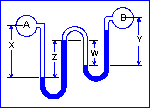 Sampling and monitoring equipment is available to quantify exposures to contaminants, noise, radiation, and heat. Correct sampling strategy and interpretation are essential elements of an industrial hygiene survey. Confined spaces, ventilation changes, the performance of collection systems, and pressure relief valves are all items of concern for exposure evaluation.
Sampling and monitoring equipment is available to quantify exposures to contaminants, noise, radiation, and heat. Correct sampling strategy and interpretation are essential elements of an industrial hygiene survey. Confined spaces, ventilation changes, the performance of collection systems, and pressure relief valves are all items of concern for exposure evaluation.Industrial hygiene is defined as the recognition, evaluation, and control of workplace hazards. Its origins are based on limiting personal exposures to chemicals, and have evolved to address the control of most other workplace hazards including over-exposure to noise, heat, vibration, and repetitive motion.
 Occupational exposure to chemicals is still considered one of the most wide spread hazards in industry. The use of engineering controls is the preferred method of limiting these exposures. Dilution and capture ventilation are two important methods to control occupational exposure. The design and position of hoods and vents, and amount of air infiltration can substantially change exposure conditions. Material Safety Data Sheets and other documentation provide a basis for predicting adverse effects, disposal needs, and fire and ignition concerns.
Occupational exposure to chemicals is still considered one of the most wide spread hazards in industry. The use of engineering controls is the preferred method of limiting these exposures. Dilution and capture ventilation are two important methods to control occupational exposure. The design and position of hoods and vents, and amount of air infiltration can substantially change exposure conditions. Material Safety Data Sheets and other documentation provide a basis for predicting adverse effects, disposal needs, and fire and ignition concerns. The selection of appropriate personal protective equipment for exposure control often requires both an understanding of the limitations of the equipment, and the expected exposure parameters as determined by an industrial hygiene evaluation. Engineering controls are considered the preferred method of control, but personal protective equipment plays an important role for health, safety, and rescue, especially when using confined space entry procedures. The potential for misuse or misapplication of these devices should be evaluated.
The selection of appropriate personal protective equipment for exposure control often requires both an understanding of the limitations of the equipment, and the expected exposure parameters as determined by an industrial hygiene evaluation. Engineering controls are considered the preferred method of control, but personal protective equipment plays an important role for health, safety, and rescue, especially when using confined space entry procedures. The potential for misuse or misapplication of these devices should be evaluated. The Occupational Safety and Health Administration, the American Conference of Governmental Industrial Hygienists, and the National Institute of Occupational Safety and Health are three organizations which establish many of the rules governing allowable workplace exposures. Permissible exposure limits for noise, chemicals, heat, and other workplace stressors have been established and often include safety factors.
The Occupational Safety and Health Administration, the American Conference of Governmental Industrial Hygienists, and the National Institute of Occupational Safety and Health are three organizations which establish many of the rules governing allowable workplace exposures. Permissible exposure limits for noise, chemicals, heat, and other workplace stressors have been established and often include safety factors.HAZARD & OPERABILITY STUDIES
INTRODUCTION
The technique of Hazard and Operability Studies, or in more common terms HAZOPS, has been used and developed over approximately four decades for 'identifying potential hazards and operability problems' caused by 'deviations from the design intent' of both new and existing process plants. Before progressing further, it might be as well to clarify some aspects of these statements.
Potential Hazard AND Operability Problems
You will note the capitalised 'AND' in the heading above. Because of the high profile of production plant accidents, emphasis is too often placed upon the identification of hazards to the neglect of potential operability problems. Yet it is in the latter area that benefits of a Hazop Study are usually the greatest. To quote an example, a study was commissioned for a new plant. Some two years previously, and for the first time, a similar study had been carried out on different plant at the same site which was then in the process of being designed. Before the latest review commenced, the Production Manager expressed the hope that the same benefits would accrue as before, stating that "in his twenty years of experience, never had a new plant been commissioned with so few problems, and no other plant had ever achieved its production targets and break-even position in so short a time".
Deviation from design intent
To deal firstly with 'design intent', all industrial plant is designed with an overall purpose in mind. It may be to produce a certain tonnage per year of a particular chemical, to manufacture a specified number of cars, to process and dispose of a certain volume of effluent per annum, etc. That could be said to be the main design intent of the plant, but in the vast majority of cases it would also be understood that an important subsidiary intent would be to conduct the operation in the safest and most efficient manner possible.
With this in mind equipment is designed and constructed which, when it is all assembled and working together, will achieve the desired goals. However, in order to do so, each item of equipment, each pump and length of pipework, will need to consistently function in a particular manner. It is this manner which could be classified as the 'design intent' for that particular item. To illustrate, imagine that as part of the overall production requirement we needed a cooling water facility. For this we would almost certainly have cooling water circuit pipework in which would be installed a pump as very roughly illustrated below.
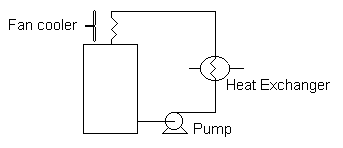
Industries in which the technique is employed
Hazops were initially 'invented' by ICI in the United Kingdom, but the technique only started to be more widely used within the chemical process industry after the Flixborough disaster in 1974. This chemical plant explosion killed twenty eight people and injured scores of others, many of those being members of the public living nearby. Through the general exchange of ideas and personnel, the system was then adopted by the petroleum industry, which has a similar potential for major disasters. This was then followed by the food and water industries, where the hazard potential is as great, but of a different nature, the concerns being more to do with contamination rather than explosions or chemical releases.
The reasons for such widespread use of Hazops
Safety and reliability in the design of plant initially relies upon the application of various codes of practise, or design codes and standards. These represent the accumulation of knowledge and experience of both individual experts and the industry as a whole. Such application is usually backed up by the experience of the engineers involved, who might well have been previously concerned with the design, commissioning or operation of similar plant.
However, it is considered that although codes of practise are extremely valuable, it is important to supplement them with an imaginative anticipation of deviations which might occur because of, for example, equipment malfunction or operator error. In addition, most companies will admit to the fact that for a new plant, design personnel are under pressure to keep the project on schedule. This pressure always results in errors and oversights. The Hazop Study is an opportunity to correct these before such changes become too expensive, or 'impossible' to accomplish.
Although no statistics are available to verify the claim, it is believed that the Hazop methodology is perhaps the most widely used aid to loss prevention. The reason for this can most probably be summarised as follows:
- It is easy to learn.
- It can be easily adapted to almost all the operations that are carried out within process industries.
- No special level of academic qualification is required. One does not need to be a university graduate to participate in a study.
THE BASIC CONCEPT
Essentially the Hazops procedure involves taking a full description of a process and systematically questioning every part of it to establish how deviations from the design intent can arise. Once identified, an assessment is made as to whether such deviations and their consequences can have a negative effect upon the safe and efficient operation of the plant. If considered necessary, action is then taken to remedy the situation.
This critical analysis is applied in a structured way by the Hazop team, and it relies upon them releasing their imagination in an effort to discover credible causes of deviations. In practice, many of the causes will be fairly obvious, such as pump failure causing a loss of circulation in the cooling water facility mentioned above. However, the great advantage of the technique is that it encourages the team to consider other less obvious ways in which a deviation may occur, however unlikely they may seem at first consideration. In this way the study becomes much more than a mechanistic check-list type of review. The result is that there is a good chance that potential failures and problems will be identified which had not previously been experienced in the type of plant being studied.
Keywords
An essential feature in this process of questioning and systematic analysis is the use of keywords to focus the attention of the team upon deviations and their possible causes. These keywords are divided into two sub-sets:
- Primary Keywords which focus attention upon a particular aspect of the design intent or an associated process condition or parameter.
- Secondary Keywords which, when combined with a primary keyword, suggest possible deviations.
The entire technique of Hazops revolves around the effective use of these keywords, so their meaning and use must be clearly understood by the team. Examples of often used keywords are listed below.
Primary Keywords
These reflect both the process design intent and operational aspects of the plant being studied. Typical process oriented words might be as follows. The list below is purely illustrative, as the words employed in a review will depend upon the plant being studied.
| Flow | Temperature | |
| Pressure | Level | |
| Separate (settle, filter, centrifuge) | Composition | |
| React | Mix | |
| Reduce (grind, crush, etc.) | Absorb | |
| Corrode | Erode |
Note that some words may be included which appear at first glance to be completely unrelated to any reasonable interpretation of the design intent of a process. For example, one may question the use of the word Corrode, on the assumption that no one would intend that corrosion should occur. Bear in mind, however, that most plant is designed with a certain life span in mind, and implicit in the design intent is that corrosion should not occur, or if it is expected, it should not exceed a certain rate. An increased corrosion rate in such circumstances would be a deviation from the design intent.
Remembering that the technique is called Hazard & OperabilityStudies, added to the above might be relevant operational words such as:
| Isolate | Drain | |
| Vent | Purge | |
| Inspect | Maintain | |
| Start-up | Shutdown |
This latter type of Primary Keyword is sometimes either overlooked or given secondary importance. This can result in the plant operator having, for example, to devise impromptu and sometimes hazardous means of taking a non-essential item of equipment off-line for running repairs because no secure means of isolation has been provided. Alternatively, it may be discovered that it is necessary to shut down the entire plant just to re-calibrate or replace a pressure gauge. Or perhaps during commissioning it is found that the plant cannot be brought on-stream because no provision for safe manual override of the safety system trips has been provided.
Secondary Keywords
As mentioned above, when applied in conjunction with a Primary Keyword, these suggest potential deviations or problems. They tend to be a standard set as listed below:
| Word | Meaning | |
|---|---|---|
| No | The design intent does not occur (e.g. Flow/No), or the operational aspect is not achievable (Isolate/No) | |
| Less | A quantitative decrease in the design intent occurs (e.g. Pressure/Less) | |
| More | A quantitative increase in the design intent occurs (e.g. Temperature/More) | |
| Reverse | The opposite of the design intent occurs (e.g. Flow/Reverse) | |
| Also | The design intent is completely fulfilled, but in addition some other related activity occurs (e.g. Flow/Also indicating contamination in a product stream, or Level/Also meaning material in a tank or vessel which should not be there) | |
| Other | The activity occurs, but not in the way intended (e.g. Flow/Other could indicate a leak or product flowing where it should not, or Composition/Other might suggest unexpected proportions in a feedstock) | |
| Fluctuation | The design intention is achieved only part of the time (e.g. an air-lock in a pipeline might result in Flow/Fluctuation) | |
| Early | Usually used when studying sequential operations, this would indicate that a step is started at the wrong time or done out of sequence | |
| Late | As for Early |
It should be noted that not all combinations of Primary/Secondary words are appropriate. For example, Temperature/No (absolute zero or -273ºC !) or Pressure/Reverse could be considered as meaningless.
HAZOP STUDY METHODOLOGY
In simple terms, the Hazop study process involves applying in a systematic way all relevant keyword combinations to the plant in question in an effort to uncover potential problems. The results are recorded in columnar format under the following headings:
| DEVIATION | CAUSE | CONSEQUENCE | SAFEGUARDS | ACTION |
In considering the information to be recorded in each of these columns, it may be helpful to take as an example the simple schematic below. Note that this is purely representational, and not intended to illustrate an actual system.
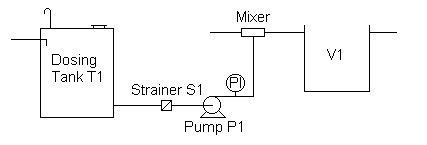
Cause
Potential causes which would result in the deviation occurring. (e.g. "Strainer S1 blockage due to impurities in Dosing Tank T1" might be a cause of Flow/No).
Potential causes which would result in the deviation occurring. (e.g. "Strainer S1 blockage due to impurities in Dosing Tank T1" might be a cause of Flow/No).
Consequence
The consequences which would arise, both from the effect of the deviation (e.g. "Loss of dosing results in incomplete separation in V1") and, if appropriate, from the cause itself (e.g. "Cavitation in Pump P1, with possible damage if prolonged").
The consequences which would arise, both from the effect of the deviation (e.g. "Loss of dosing results in incomplete separation in V1") and, if appropriate, from the cause itself (e.g. "Cavitation in Pump P1, with possible damage if prolonged").
Always be explicit in recording the consequences. Do not assume that the reader at some later date will be fully aware of the significance of a statement such as "No dosing chemical to Mixer". It is much better to add the explanation as set out above.
When assessing the consequences, one should not take any credit for protective systems or instruments which are already included in the design. For example, suppose the team had identified a cause of Flow/No (in a system which has nothing to do with the one illustrated above) as being spurious closure of an actuated valve. It is noticed that there is valve position indication within the Central Control Room, with a software alarm on spurious closure. They may be tempted to curtail consideration of the problem immediately, recording something to the effect of "Minimal consequences, alarm would allow operator to take immediate remedial action". However, had they investigated further they might have found that the result of that spurious valve closure would be over pressure of an upstream system, leading to a loss of containment and risk of fire if the cause is not rectified within three minutes. It only then becomes apparent how inadequate is the protection afforded by this software alarm.
Safeguards
Any existing protective devices which either prevent the cause or safeguard against the adverse consequences would be recorded in this column. For example, you may consider recording "Local pressure gauge in discharge from pump might indicate problem was arising". Note that safeguards need not be restricted to hardware… where appropriate, credit can be taken for procedural aspects such as regular plant inspections (if you are sure that they will actually be carried out!).
Any existing protective devices which either prevent the cause or safeguard against the adverse consequences would be recorded in this column. For example, you may consider recording "Local pressure gauge in discharge from pump might indicate problem was arising". Note that safeguards need not be restricted to hardware… where appropriate, credit can be taken for procedural aspects such as regular plant inspections (if you are sure that they will actually be carried out!).
Action
Where a credible cause results in a negative consequence, it must be decided whether some action should be taken. It is at this stage that consequences and associated safeguards are considered. If it is deemed that the protective measures are adequate, then no action need be taken, and words to that effect are recorded in the Action column.
Where a credible cause results in a negative consequence, it must be decided whether some action should be taken. It is at this stage that consequences and associated safeguards are considered. If it is deemed that the protective measures are adequate, then no action need be taken, and words to that effect are recorded in the Action column.
Actions fall into two groups:
- Actions that remove the cause.
- Actions that mitigate or eliminate the consequences.
Whereas the former is to be preferred, it is not always possible, especially when dealing with equipment malfunction. However, always investigate removing the cause first, and only where necessary mitigate the consequences. For example, to return to the "Strainer S1 blockage due to impurities etc." entry referred to above, we might approach the problem in a number of ways:
- Ensure that impurities cannot get into T1 by fitting a strainer in the road tanker offloading line.
- Consider carefully whether a strainer is required in the suction to the pump. Will particulate matter pass through the pump without causing any damage, and is it necessary to ensure that no such matter gets into V1. If we can dispense with the strainer altogether, we have removed the cause of the problem.
- Fit a differential pressure gauge across the strainer, with perhaps a high dP alarm to give clear indication that a total blockage is imminent.
- Fit a duplex strainer, with a regular schedule of changeover and cleaning of the standby unit.
Three notes of caution need to be borne in mind when formulating actions. Do not automatically opt for an engineered solution, adding additional instrumentation, alarms, trips, etc. Due regard must be taken of the reliability of such devices, and their potential for spurious operation causing unnecessary plant down-time. In addition, the increased operational cost in terms of maintenance, regular calibration, etc. should also be considered (the lifetime cost of a simple instrument will be at least twice its purchase price… for more complex instrumentation this figure will be significantly greater). It is not unknown for an over-engineered solution to be less reliable than the original design because of inadequate testing and maintenance.
Finally, always take into account the level of training and experience of the personnel who will be operating the plant. Actions which call for elaborate and sophisticated protective systems are wasted, as well as being inherently dangerous, if operators do not, and never will, understand how they function. It is not unknown for such devices to be disabled, either deliberately or in error, because no one knows how to maintain or calibrate them.
Considering all Keywords - The Hazop procedure
Having gone through the operations involved in recording a single deviation, these can now be put into the context of the actual study meeting procedure. From the flow diagram below it can be seen that it is very much an iterative process, applying in a structured and systematic way the relevant keyword combinations in order to identify potential problems.
Chemicals have become a part of our life for sustaining many of our day-to-day activities, preventing and controlling diseases, and increasing agricultural productivity etc. An estimation of one thousand new chemicals enter the market every year, and about 100000 chemical substances are used on a global scale. These chemicals are mostly found as mixtures in commercial products. Over one million such products or trade names are available.
The chemical industrial sector is highly heterogeneous encompassing many sectors like organic, inorganic chemicals, dyestuffs, paints, pesticides, specialty chemicals, etc. Some of the prominent individual chemical industries are caustic soda, soda ash, carbon black, phenol, acetic acid, methanol and azo dyes. Chemical manufacturing sector in India is well established and has recorded a steady growth in the overall Indian industrial scenario. The Chemical and allied industries have been amongst the faster growing segments of the Indian industry. The Indian chemical industrial sector had a turnover of around Rs.1200 billion in 2001-2002. The chemical exports also accounts for more than 16.20% of the total Indian exports during 2001-2002.
The risks associated with the chemical industry are commensurate with their rapid growth and development. Apart from their utility, chemicals have their own inherent properties and hazards. Some of them can be flammable, explosive, toxic or corrosive etc. The whole lifecycle of a chemical should be considered when assessing its dangers and benefits. Though many of chemical accidents have a limited effect, occasionally there are disasters like the one in Bhopal, India, in 1984, where lakhs of people were affected and LPG explosion in Vizag refinery where huge property damage in addition to 60 deaths was experienced. Therefore chemicals have the potential to affect the nearby environment also.
· Design and Pre-modification review : Improper layout like location of plant in down wind side of tank farm , fire station near process area , process area very close to public road and wrong material of selection had caused severe damages to the work and outside environment
· Chemical Risk Assessment: Not assessed for new chemicals from the point of view of compatibility, storage, fire protection, toxicity, hazard index rating, fire and explosion hazards
· Process Safety Management: HAZOP, FTA, F&E Index calculation, reliability assessment of process equipment, incorporating safety trips and interlocks, scrubbing system, etc. not done before effecting major process changes, lack of Management of Change procedure (MoC), etc.
· Electrical Safety: Hazardous area classification , protection against static electricity , improper maintenance of specialized equipment like flameproof etc were ignored.
· Safety Audits: Periodical assessment of safety procedures and practices, performance of safety systems and gadgets along with follow up measures were not carried out.
· Emergency Planning: Lack of comprehensive risk analysis indicating the impact of consequences and specific written down and practiced emergency procedures along with suitable facilities had increased the severity of the emergency situations.
· Training: Safety induction and periodical refresher training for the regular employees and contract workmen were not carried out.
· Risk Management & Insurance Planning: Thorough identification and analysis of all risks and insurance planning were not done so that interruption risks and public liability risks could also be managed effectively.
A. Risk Management
Following specialized risk management services are required to chemical industries, considering the kind of risks that exists in these plant operations:
1. STANDARD CONFORMANCE and PERFORMANCE EVALUATION (SCOPE)
SCOPE would evaluate the existing measures / system based on applicable national / international standards.
A few SCOPE reviews that we recommend for chemical manufacturing plants are:
1.1 SCOPE-FP (Fire Protection)
Indian Standards
· IS 2189 - Standard for automatic fire detection and alarm system
· IS 2190 - Code of practice for selection, installation and maintenance of first aid fire extinguishers
· IS 3844 - Code of practice for installation and maintenance of internal fire hydrants and hose reels
· IS 6382 - Carbon dioxide fire extinguishing system - fixed, design and installation
TAC Standard
Tariff Advisory Committee recommendations on hydrant and sprinkler system for fire protection.
Oil Industry Safety Directorate
· OISD 117 - Fire Protection Facilities for Petroleum Depots and Terminals
· OISD 142 - Inspection of fire fighting equipment and systems
· OISD 158 - Recommended Practices on Storage and Handling of Bulk Liquefied Petroleum Gas
NFPA Standards
· NFPA 12 Carbon Dioxide Fire Extinguishing Systems
· NFPA 654 Prevention of Fire & Dust in Pharmaceutical Industries
· NFPA 1600 Disaster Management
· NFPA 921 Fire & Explosion Investigation
· NFPA 45 Fire protection for Laboratories using Chemicals
1.2 SCOPE - OHS (Occupational Health and Safety)
· IS 14489 Code of Practice for Occupational Safety & Health Audit
· NFPA 101 Life Safety Code
1.3 SCOPE-ER (Electrical Risk)
· Hazardous Area Classification (base standard: IS 5572)
· Selection of Electrical Equipment for Hazardous Areas (base standard: IS 5571)
· Lightning Protection (base document: IS: 2309 /NFPA 780 /BS 6651)
· NFPA 70 BRecommended Practice for Electrical Equipment Maintenance
· NFPA 70 EStandard for Electrical Safety in Employee Work places
2.0 PROCESS SAFETY MANAGEMENT
· Hazard & Operability (HAZOP) studies
· Failure Tree Analysis (FTA)
· Event Tree Analysis (ETA)
· Primary Hazard Analysis (PHA) using Dow Index
· Risk Assessment (with risk ranking technique)
3.0 ELECTRICAL RISK ASSESSMENT
· Review of Hazardous Area Classification
· Lightning Protection Risk Assessment
· Identification & Control of Electro-Static Hazards
· Review of electrical Preventive Maintenance System
· Electrical Risk Assessment (fire, shock explosion) using Semi-Quantitative Risk Ranking (SQRR) technique
4.0 FIRE RISK ASSESSMENT
· Identification & assessment of fire risks during operations in receipt, storage, transfer and handling of chemicals (raw materials and finished products)
· Identification & control of ignition sources in areas where flammable chemicals are stored / handled / transferred
o Review of chemical compatibility in storage areas and to suggest appropriate fire loss control measures
o Review of fire detection measures adopted in the plant & to suggest suitable improvement measures
o Review of the various active (fire hydrant, sprinkler, portable fire extinguishers) and passive fire protection requirements for chemical storage and handling areas and to suggest improvements as necessary
o Review of contractor safety awareness (chemical spill, fire fighting, emergency communication, knowledge of plant hazards & safety regulations) and to recommend suitable improvement measures to enhance contractor safety
o Review of safety awareness and safety training requirements ( training identification and efficacy) of plant employees with respect to hazards present in the plant
Fire risk assessment will be carried out based on techniques like Matrix method, Hani Raafat Risk Calculator. The consequence, likelihood and exposure of each hazard are arrived using a systematic approach and will help to determine the relative importance of hazard and focus on significant risks.
5.0 RISK ANALYSIS & EMERGENCY PLAN
· Identification of scenarios of potential disasters / emergencies leading to loss of life , property damage etc. and qualitative assessment of their likelihood.
· Quantitative risk assessment for selected scenarios of major credible events.
· Recommendations for risk control measures wherever applicable.
· Preparation of onsite emergency preparedness plan
6.0 RISK MANAGEMENT & INSURANCE PLANNING
- Identification of all major internal and external pure risks including the natural risks and analysis of the impact of above risks
- Review of existing risk control measures and offering comments
- Scrutiny of all existing major insurance policies in respect of:
- Rationalization of basic rate of premium and widening of covers
- Applicability / eligibility of discounts in premium
- Application of suitable clauses, warranties and conditions
- Identification of possible areas for refund of premium and suggestions regarding procedure for the same
- Selection of insurance coverage on the basis of risk analysis
- Providing guidelines for fixation of sum insured and illustrate the same on a selected equipment
- Evaluation of business interruption exposure due to identified risks
- Providing guidelines on documentation requirements, procedures for claims under various policies, evaluation of insurers
B. Risk Management Training
Specialized and focussed training, if imparted effectively, can contribute significantly to Risk Management. Expert faculty, carefully selected training module, interactive and participate approach, useful training material, case studies and syndicate exercises could help in having effective risk management system in place. The training topics for bulk drug industry could be:
· Chemical Safety
· Safety with Compressed gases
· Solvent Safety
· Hazard Identification Techniques
· Industrial Risk Management
· Fire Prevention and Protection
· Electrical Risk Management
· Emergency Preparedness
· Safety Management system
· Accident Prevention
· Personal Protective Equipment
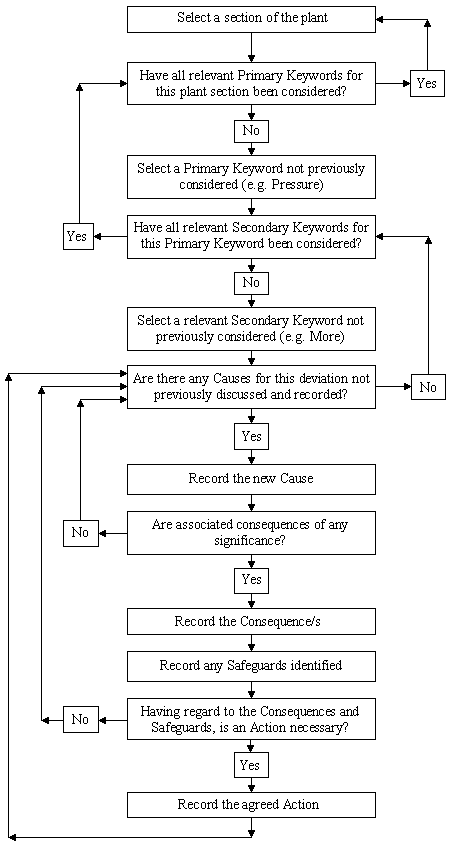
↧
10-Day Weather Forecast OF KAKINADA
http://www.wunderground.com/weather-forecast/IN/Kakinada.html
Saturday 05/24 20% Mostly cloudy. Low 28C. Winds S at 10 to 15 kph. | |
Tonight 05/24 20% Mostly cloudy. Low 28C. Winds S at 10 to 15 kph. | |
Tomorrow 05/25 20% Considerable cloudiness. High 36C. Winds SSE at 15 to 25 kph. | |
Tomorrow night 05/25 40% Variable clouds with scattered thunderstorms. Low near 27C. Winds SE at 10 to 15 kph. Chance of rain 40%. | |
Monday 05/26 40% Scattered thunderstorms in the morning, then mainly cloudy late. High 36C. Winds SSE at 10 to 15 kph. Chance of rain 40%. | |
Monday night 05/26 20% Partly cloudy skies during the evening will give way to cloudy skies overnight. Low 28C. Winds S at 10 to 15 kph. |
↧
Fertilizer producer IFFCO looks for revised subsidies
Fertilizer producer IFFCO looks for revised subsidies
NEW YORK - India's largest fertilizer producer, Indian Farmers Fertiliser Cooperative (IFFCO), expects the country's new government to shake up its fertilizer subsidy program, possibly spurring greater phosphate and potash use to boost crop production.
Two major fertilizer suppliers to the world's second-biggest wheat producer, Potash Corp of Saskatchewan (POT.TO) and Mosaic Co (MOS.N), also said on Thursday they expected changes by the Narendra Modi government to the subsidy program, which is a big factor in how much fertilizer Indian farmers buy.
"I think we'll see a shift in government to more balanced application," said Manish Gupta, IFFCO's director of strategy and joint ventures, at BMO's Farm to Market conference in New York.
"Something will surely happen on this."
Modi thundered to electoral victory on Friday in a seismic political shift that gives his party a mandate for sweeping economic reform.
Changing the subsidy program is critical if India is to maximize crop production, Gupta said. Indian fertilizer companies rely entirely on imported potash and heavily on phosphate produced elsewhere.
Since 2010, India has reduced its subsidies for potash and phosphate. That has resulted in urea becoming a more attractive option for farmers relative to the two other fertilizers, leading to an imbalance of nutrients in the soil.
The subsidy program "probably can't get any worse," said Potash Corp Chief Financial Officer Wayne Brownlee, speaking at the BMO conference. "When you have the first majority government in 30 years there is an opportunity for sound policies to prevail over impulse politics.”
India is the biggest global phosphate importer and a top consumer of potash. Slack Indian fertilizer demand is one reason for a plunge in profits by Potash Corp and Mosaic.
It is unlikely that India, facing a deficit, can afford to raise subsidies for potash and phosphate. But it could cut the urea subsidy or target subsidies only to poorer farmers, Gupta said, although he noted that tinkering with urea prices was politically sensitive.
Both Potash Corp and Mosaic forecast increased Indian imports even before the election result.
Potash Corp said in January that it expects India to import 3.7 million to 4.2 million tonnes of potash from all suppliers in 2014, up from 3.1 million last year, due to thin Indian inventories and a small bump in consumption.
Mosaic sees phosphate imports jumping to about 9 million or 9.2 million tonnes of phosphate in 2014, up from 8 million.
Change to subsidies may take awhile, Mosaic Chief Financial Officer Larry Stranghoener said in an interview.
"We would love to see a fundamental change in the subsidy system. I think that may be a bridge too far for a new government to take on immediately."
A trend toward urbanization, along with higher incomes and demand for more protein-rich food, has made India, China and Southeast Asian countries key growth markets for grains and fertilizer.
(Additional reporting by Nicole Mordant in Vancouver; Editing by Tom Brown)
↧


